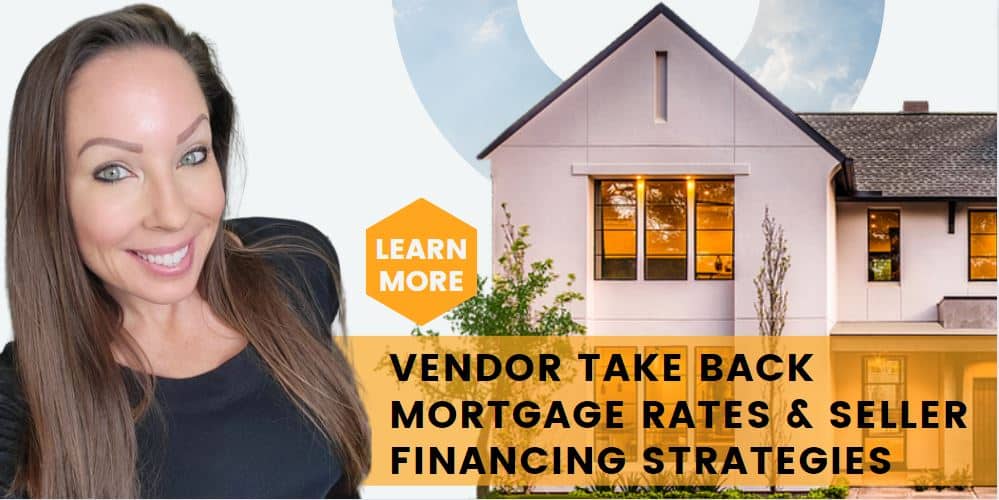
Leveraging Vendor Take Back Mortgage Rates To Buy A Property
Vendor take back mortgage rates may not necessarily compete with the banks when it comes to buying a home, but seller financing may be a strategy to consider if you can’t qualify traditionally. In this comprehensive article, I am outlining tactics that you may not have thought of when it comes to buying a property – for yourself – or to rent out as an investment.
When it comes to buying real estate in Canada, the traditional route typically involves securing a mortgage from a bank or other financial institution. However, there are alternative financing options available, such as seller financing, also known as vendor take back mortgages as well as rent to own. Let’s explore how these financing methods work in the Canadian real estate market and the advantages and disadvantages they offer to both buyers and sellers.
UNDERSTANDING SELLER FINANCING
Seller financing, also known as vendor financing, occurs when the seller of a property provides financing to the buyer instead of the buyer obtaining a traditional mortgage from a bank or lender. In essence, the seller becomes the lender, and the buyer makes regular payments directly to the seller. Naturally, this also comes with vendor take back mortgage rates to go along with the terms of the agreement.
HOW SELLER FINANCING WORKS
- Negotiating Terms: The buyer and seller negotiate the terms of the financing agreement, including the vendor take back mortgage rates, the down payment, and repayment schedule. These terms are generally far more flexible than those offered by traditional lenders.
- Legal Agreement: A formal legal agreement is drawn up, outlining the terms and conditions of the seller financing arrangement. This agreement is typically registered on the property title to protect the seller’s interests.
- Closing Process: The sale of the property proceeds as usual, with the buyer paying the agreed-upon down payment. The seller then holds a mortgage on the property for the remaining purchase price based on the vendor take back mortgage rates agreed upon.
- Repayment: The buyer makes regular mortgage payments to the seller, including principal and interest, as per the agreed-upon schedule.
ADVANTAGES OF SELLER FINANCING FOR HOME BUYERS
- Easier Qualification: Seller financing can be more accessible for buyers who may not qualify for a traditional mortgage due to credit issues or a lack of a substantial down payment.
- Flexible Terms: Buyers and sellers have the flexibility to negotiate terms and vendor take back mortgage rates that suit both parties, potentially resulting in more favourable conditions than those offered by banks.
- Quick Closing: Seller financing can expedite the purchasing process, as it often involves fewer bureaucratic hurdles and less paperwork compared to traditional mortgages.
ADVANTAGES OF SELLER FINANCING FOR THE SELLERS
- Higher Sales Price: Sellers can often command a higher selling price by offering seller financing, as it expands the pool of potential buyers who may not have access to conventional financing. Vendor take back mortgages are unique and not overly common so this goes in hand with the process.
- Regular Income: Sellers receive regular mortgage payments from the buyer, providing a steady stream of income without the need for ongoing property management.
- Interest Income: Sellers can earn interest income on the mortgage, potentially yielding a higher return on investment compared to other investment options.
UNDERSTANDING VENDOR TAKE BACK MORTGAGE RATES & TERMS (VTB)
Vendor Take Back Mortgages (VTB) are a specific type of seller financing where the seller agrees to lend a portion of the property’s purchase price to the buyer. In a VTB, the seller effectively becomes the lender, and the buyer assumes a traditional mortgage from a financial institution to cover the remainder of the purchase price.
HOW VENDOR TAKE BACK MORTGAGES WORK
- Negotiating Terms: As with seller financing, the buyer and seller negotiate the terms of the VTB, including the vendor take back mortgage rate, down payment, and repayment schedule.
- Legal Agreement: A formal legal agreement is drawn up, outlining the terms and conditions of the VTB. This agreement is typically registered on the property title to protect the seller’s interests.
- Traditional Mortgage: The buyer secures a traditional mortgage from a bank or lender to cover the portion of the purchase price not covered by the VTB.
- Closing Process: The sale of the property proceeds as usual, with the buyer paying the agreed-upon down payment. The seller holds a mortgage on the property for the portion covered by the VTB.
- Repayment: The buyer makes regular mortgage payments to both the seller (VTB) and the traditional lender, following the agreed-upon schedules for each.
ADVANTAGES OF VENDOR TAKE BACK MORTGAGE FOR BUYERS
- Lower Down Payment: Home buyers and real estate investors may benefit from a lower down payment requirement when they can secure a VTB, allowing them to enter the housing market with less upfront capital.
- More Favourable Terms: Buyers can potentially negotiate more favorable terms for the VTB portion of their mortgage, including competitive interest rates and flexible repayment schedules.
- Improved Qualification: A VTB can help buyers who may not qualify for a traditional mortgage to secure financing.
ADVANTAGES OF VENDOR TAKE BACK MORTGAGES FOR SELLERS
- Higher Selling Price: Similar to seller financing, VTBs can allow sellers to command a higher selling price and attract a broader range of potential buyers.
- Interest Income: Sellers can earn interest income on the VTB portion of the mortgage, potentially offering a better return on investment than other options.
- Portfolio Diversification: Sellers can diversify their investment portfolio by holding VTB mortgages, spreading their risk across different asset classes.
While seller financing and VTBs offer advantages, they also come with unique challenges and considerations for both buyers and sellers.
For example, both parties should conduct thorough due diligence to assess the financial stability and creditworthiness of the other party. This is an essential component of completing a risk assessment. In addition, leveraging legal professionals is imperative. And, not just any regular real estate lawyer may do. You should look into a lawyer who has proven experience in seller financing and VTB transactions to protect yourself and ensure you have a sound agreement.
Another important consideration are the vendor take back mortgage rates. The interest rates for seller financing and VTBs should be competitive and reflective of the current market conditions. Negotiating fair rates is key.
The other aspect are the terms of the agreement. This must include default and foreclosure details in the unforeseen circumstances this arises. Sellers should be aware of the potential consequences of buyer default and the process of foreclosure if payments are not made as agreed. This should also cover the exit strategy. Sellers should have a well-defined exit strategy in case they need to sell the VTB or seller-financed mortgage to access their investment.
Last but not least, insurance is very important as well. Buyers should have mortgage insurance to protect their investment, as should the sellers.
Seller financing can be an attractive avenue if traditional financing is just not an option for you. Vendor take back mortgage rates and terms can provide flexible financing options that can benefit both buyers and sellers in the Canadian real estate market. These arrangements offer potentially lower down payment requirements, and the opportunity for sellers to earn interest income. However, they also come with unique challenges and considerations that both parties should carefully evaluate. When structured thoughtfully and legally, seller financing and VTBs can provide a win-win solution for buyers looking to enter the housing market and sellers seeking to maximize their return on investment.
Thinking of buying, selling or investing in Durham Region or East Toronto? Let’s chat! I can be reached at 647.896.6584, by email at info@serenaholmesrealtor.com or by filling out this simple contact form.
For plenty of other great content, make sure we’re connected on social @serenaholmesrealtor and you’ve subscribed to my YouTube Channel. In addition, make sure you’ve subscribed to my monthly realtor report.










